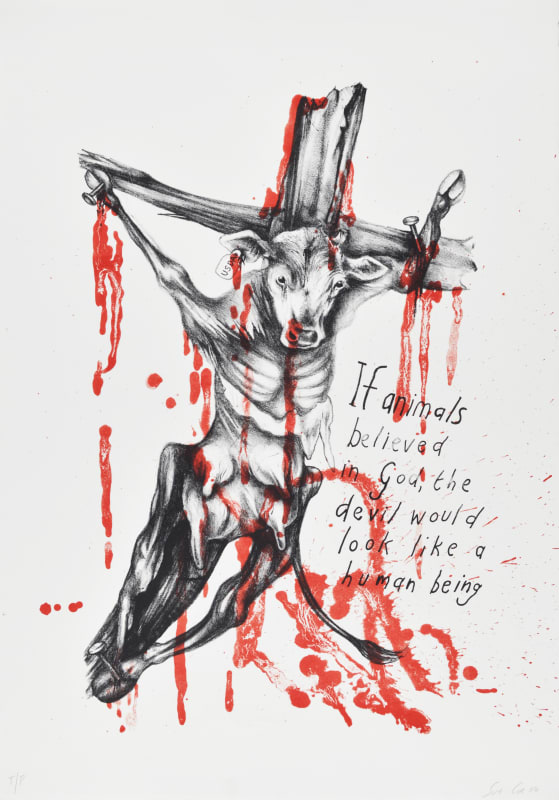Live painting is popular at art parties because it emphasizes the handmade and the spontaneous over the reproduced. But live illustration? Famous illustrator Sue Coe experimented with such a form last week before the opening of her exhibition at the Pacific Northwest College of Art.
At lunchtime Thursday, Coe, a middle-age Brit who has lived in the U.S. for 35 years, huddles with a dozen students, about half of whom are majoring in illustration. A large canvas, stretched and gessoed, hangs in the common area of the art school.
Coe starts slowly writing words at the top of the canvas in red house paint with a brush taped to the end of a long stick. Using charcoal, the students render onto the canvas what soon reveal themselves to be three-dimensional crosses.
Coe has written 'If animals believed … '
Crowding together in front of the canvas, they gradually outline animals. One draws a dolphin on his cross. Another, kneeling, sketches a small swan. Then the students begin filling in the shapes with red and black paint.
Coe's writing goes on, one wobbly letter at a time. 'If animals believed in God,' although her 'G' looks like an 's,' giving rise to muted discussions of authorial intent around the room.
Her work - examples of which are on display in the school's Feldman Gallery - focuses on the facts of such horrific subjects as HIV-positive prisoners or the treatment of animals in factory farming.
One sequence, for example, is based on a news item about a shipwreck. One person died. So did 60,000 sheep that were being transported live from Australia to Jordan to be slaughtered locally.
Martin French, chairman of PNCA's illustration department, says his 50 students have grown up with heavy exposure to the imagery of animated movies, video games and comics. Portland being a zine and comics town helps.
'So much of their experience as young artists is around this art form of illustration,' he says. 'It intersects with all of those, that basic skill of picture making.'
They don't just learn how to illustrate a text, he says, but how to do character design, too, and 'depict concepts and ideas based on themes and social issues,' which is how Coe works.
'If animals believed in God, the Devil would …,' continues the text.
The canvas is filling up. Coe stops one student from using the pink he has created. She wants blacks, whites and reds, which suit the goth-punk feel of her work.
A gallery blurb says, 'Coe contends that the abuse and mistreatment of animals is a variation on the theme of exploitation of the weak by the strong.'
There is now a dolphin on the cross, and a monkey, and a large cow. Coe completes the superscript:
'If animals believed in God, the Devil would look like a human being.'
The resultant Calvary is doomy and heart-wrenching. The 'Guernica'-like scale can't fail to have an impact. A few kids keep adding red.
Katie Harral, a graphics major who drew the swan, said the only instructions were to pick an animal, crucify it, and keep the proportions right.
'I chose a beautiful animal,' says Harral, who is an animal-rights sympathizer. She says Coe recommends they 'witness without power,' that is to draw the facts without opinion.
Today was about illustrating an idea, not a fact.
A committed vegan, Coe didn't vet the students to see if they were down with the theme, but she's sure they agree with her sentiments. 'I gave them no instructions whatsoever' when it came to style, she says.
- Joseph Gallivan
Sue Coe: Graphic Witness, 9 a.m. to 9 p.m. Monday-Sunday, through April 16, Pacific Northwest College of Art Feldman Gallery and Project Space, 1241 N.W. Johnson St., 503-226-4391
